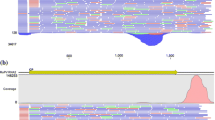Abstract
Using random high-throughput RNA sequencing, the complete coding sequence of a novel picorna-like virus (a 9,228-nt contig containing 212,202 reads) was determined from a blackbird (Turdus merula) infected with Usutu virus. This sequence shares only 36% amino acid sequence identity with its closest homolog, arivirus 1, (an unclassified member of the order Picornavirales), and shares its dicistronic genome arrangement. The new virus was therefore tentatively named “blackbird arilivirus” (ari-like virus). The nearly complete genome sequence consists of at least 9,228 nt and contains two open reading frames (ORFs) encoding the nonstructural polyprotein (2235 amino acids) and structural polyprotein (769 amino acids). Two TaqMan RT-qPCR assays specific for ORF1 confirmed the presence of high levels of this novel virus in the original sample. Nucleotide composition analysis suggests that blackbird arilivirus is of dietary (plant) origin.


Similar content being viewed by others
References
Bankevich A, Nurk S, Antipov D, Gurevich AA, Dvorkin M, Kulikov AS, Lesin VM, Nikolenko SI, Pham S, Prjibelski AD, Pyshkin AV, Sirotkin AV, Vyahhi N, Tesler G, Alekseyev MA, Pevzner PA (2012) SPAdes: a new genome assembly algorithm and its applications to single-cell sequencing. J Comput Biol 19:455–477
Finn RD, Bateman A, Clements J, Coggill P, Eberhardt RY, Eddy SR, Heger A, Hetherington K, Holm L, Mistry J, Sonnhammer EL, Tate J, Punta M (2014) Pfam: the protein families database. Nucleic Acids Res 42:D222–D230
Garigliany M, Linden A, Gilliau G, Levy E, Sarlet M, Franssen M, Benzarti E, Derouaux A, Francis F, Desmecht D (2017) Usutu virus, Belgium, 2016. Infect Genet Evol 48:116–119
Holtz LR, Cao S, Zhao G, Bauer IK, Denno DM, Klein EJ, Antonio M, Stine OC, Snelling TL, Kirkwood CD, Wang D (2014) Geographic variation in the eukaryotic virome of human diarrhea. Virology 468–470:556–564
Hunt M, Gall A, Ong SH, Brener J, Ferns B, Goulder P, Nastouli E, Keane JA, Kellam P, Otto TD (2015) IVA: accurate de novo assembly of RNA virus genomes. Bioinformatics 31:2374–2376
Kelley LA, Mezulis S, Yates CM, Wass MN, Sternberg MJ (2015) The Phyre2 web portal for protein modeling, prediction and analysis. Nat Protoc 10:845–858
Koonin EV, Wolf YI, Nagasaki K, Dolja VV (2008) The Big Bang of picorna-like virus evolution antedates the radiation of eukaryotic supergroups. Nat Rev Microbiol 6:925–939
Li H, Durbin R (2009) Fast and accurate short read alignment with Burrows–Wheeler transform. Bioinformatics 25:1754–1760
Marchler-Bauer A, Derbyshire MK, Gonzales NR, Lu S, Chitsaz F, Geer LY, Geer RC, He J, Gwadz M, Hurwitz DI, Lanczycki CJ, Lu F, Marchler GH, Song JS, Thanki N, Wang Z, Yamashita RA, Zhang D, Zheng C, Bryant SH (2015) CDD: NCBI’s conserved domain database. Nucleic Acids Res 43:D222–D226
Rosseel T, Ozhelvaci O, Freimanis G, Van Borm S (2015) Evaluation of convenient pretreatment protocols for RNA virus metagenomics in serum and tissue samples. J Virol Methods 222:72–80
Van Borm S, Lambrecht B, Vandenbussche F, Steensels M (2017) Complete coding sequence of Usutu virus strain Gracula religiosa/U1609393/Belgium/2016 obtained from the brain tissue of an infected captive common hill myna (Gracula religiosa). Genome Announc 5(12):e00042-17
Yinda CK, Zell R, Deboutte W, Zeller M, Conceicao-Neto N, Heylen E, Maes P, Knowles NJ, Ghogomu SM, Van Ranst M, Matthijnssens J (2017) Highly diverse population of Picornaviridae and other members of the Picornavirales, in Cameroonian fruit bats. BMC Genom 18:249
Acknowledgements
DVM. F. Hénin kindly collected the bird and circumstantial information. The expert technical assistance of O. Ozhelvaci, S. H. Mahibullah and A. Ausloos is much appreciated. Raw sequence data were generated by the Biotechnology and Molecular Biology Platform of the Scientific Institute for Public Health (Brussels, Belgium).
Funding
The authors received no financial support for the research, authorship, and/or publication of this article.
Author information
Authors and Affiliations
Corresponding author
Ethics declarations
Conflict of interest
The authors declare no conflict of interest.
Ethical approval
This article does not contain any studies with human participants or animals performed by any of the authors.
Additional information
Handeling Editor: Zhenhai Chen.
Electronic supplementary material
Below is the link to the electronic supplementary material.
Rights and permissions
About this article
Cite this article
Van Borm, S., Steensels, M., Mathijs, E. et al. Complete coding sequence of a novel picorna-like virus in a blackbird infected with Usutu virus. Arch Virol 163, 1701–1703 (2018). https://doi.org/10.1007/s00705-018-3761-6
Received:
Accepted:
Published:
Issue Date:
DOI: https://doi.org/10.1007/s00705-018-3761-6




